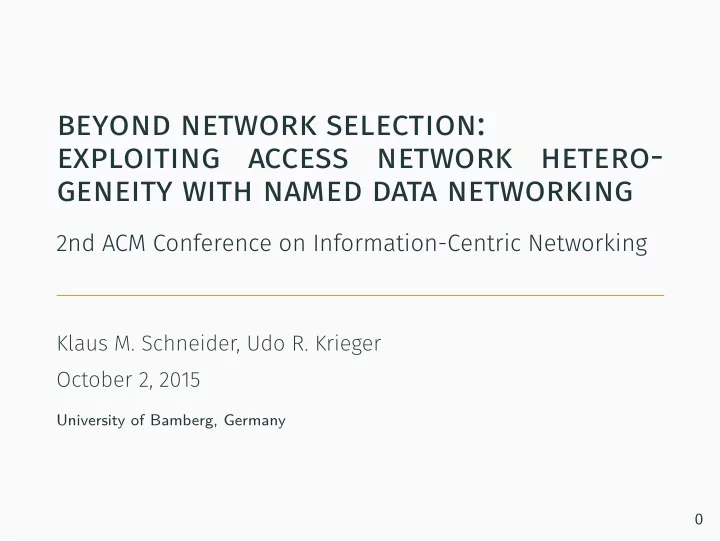

2nd ACM Conference on Information-Centric Networking . Klaus M. Schneider, Udo R. Krieger October 2, 2015 University of Bamberg, Germany 0 beyond network selection: exploiting access network hetero- geneity with named data networking
1 Source: Cisco VNI Mobile, 2015 two trends: content & mobility
2 multihomed terminal scenario L TE WiMAX Content Mobile Client WiFi Ad-hoc
2. Different Access Network Characteristics 3. Different Cost Factors Goal: Doing better than IP Network Selection 3 characteristics of the scenario Common Observations 1. Different Application Requirements
4 Source: Van Jacobson et al. - Networking Named Content (2009) solution: stateful & adaptive forwarding!
5 system architecture & design
2. Active Probing 1. Passive Monitoring 6 system architecture – interface estimation → Moving Average
7 system architecture – forwarding strategies
8 strategies - best interface first
9 strategies - packet striping
10 strategies - parallel transmission
Implementation & Evaluation 11
= TCP RTT Estimator 12 delay estimator → Exponential Moving Average
Own Loss Estimator Design! No discrete loss values! Based on Simple Moving Average 13 loss estimator
No discrete loss values! Based on Simple Moving Average 13 loss estimator Own Loss Estimator Design!
14 Uniform Packet Loss loss estimator – measurement results R1 6 5 2 e c a F Face 257 R2 F a c e 2 5 Backbone Server 8 Client R3 40 Measured Packet loss [%] 30 Face 256 (10%) 20 257 (20%) 258 (30%) 10 0 0 5 10 15 20 Time [s]
15 1. Passive Bandwidth Estimation Naive bandwidth probing of unused paths bandwidth estimator → Too much overhead! 125 Bandwidth [KByte/s] 100 Face 75 256 (1000 KB/s) 257 (500 KB/s) 50 258 (100 KB/s) 25 0 0 5 10 15 Time [s]
16 bandwidth estimator – 2. burst estimation 1000 Bandwidth [KByte/s] 800 Face 600 256 (1000 KB/s) 257 (500 KB/s) 400 258 (100 KB/s) 200 0 0 5 10 15 Time [s]
17 Cost: Ordinal attribute Example: maxdelay=500ms, maxloss=10%, prio=delay lowest cost strategy Chooses lowest cost face that satisfies all requirements! Requirements: maxloss, maxdelay, minbw R1 6 5 2 e c a F Face 257 R2 F a c e 2 5 Backbone Server 8 Client R3
18 10 sec: Loss deterioration of path 257 40 sec: Loss recovery 30 sec: Delay recovery 20 sec: Delay deterioration of path 256 lowest cost strategy – measurement results 1000 Data Rate [Pkts/s] 750 Face 256 500 257 258 250 0 0 10 20 30 40 Time [s]
More flexible requirements: Two thresholds: Min and Max Example: delay=20ms-50ms, cost 1 =10-20, cost 2 =2-5 19 madm strategy Multiple Attributes + Chooses Highest Value Interface QoE QoE QoE QoS Metric A QoS Metric B QoS Metric C
20 (1) App2: loss=0%-40%, cost=50%-70% App1: loss=0%-40% t limit madm strategy: mobile traffic limit scenario cost = t consumed 300 Packet Rate [Pkts/s] Face 256 200 257 Type 100 inData outInt 0 0 10 20 30 40 50 Time [s]
21 2. Req. not met: Use best 2 paths Scenario: Real-time communications! 1. Req. not met: Flood selective parallel strategy SP = LCS + Selective Flooding 1.00 Sent Interests [Pkts/s] 800 ● Perc. inside Req. 0.75 600 ● ● 0.50 400 0.25 200 ● ● BestRoute LCS SP−Best2 SP−Flood Broadcast BestRoute LCS SP−Best2 SP−Flood Broadcast Forwarding Strategy Forwarding Strategy
2. Realistic Evaluation Scenarios New Adaptive Forwarding Strategies 3. Congestion-Control 22 summary Adapting NDN to Wireless Multihomed Devices Interface Estimation (QoS Awareness) Future Work 1. Details of Parallel Forwarding Strategies
Thank you for your attention! Klaus Schneider klaus.schneider@uni-bamberg.de klaus@cs.arizona.edu 23 the end
Recommend
More recommend